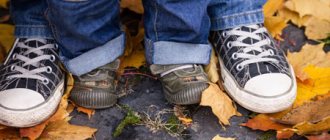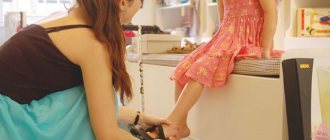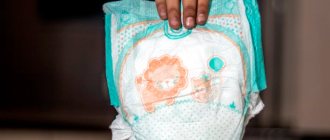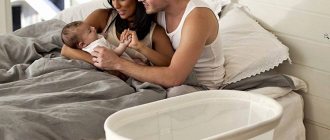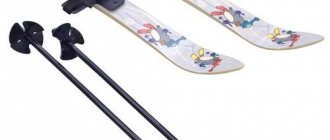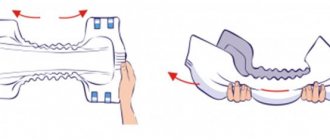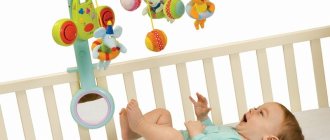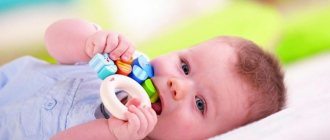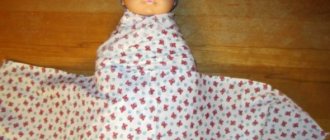The question of how to choose the right winter shoes for a child aged 1, 2, 3 years, what aspects and nuances should be paid attention to, is answered neither by the huge assortment of children's goods, nor by the presence of numerous stores. Despite the fact that this process is not simple, we will try to help in solving the problem that causes so many difficulties for older people who want to buy shoes or boots that are not only beautiful, but also ideal, warm, and comfortable for the baby. In this article we will look at what types of models there are, how they differ, in what cases they are suitable, and also what criteria are best used to make a purchase.
What to consider when choosing children's winter shoes
Before you buy children's shoes, especially winter ones, you need to try them on your baby and make sure that they suit him in all respects.
Consider the fullness of the leg, which may vary. The leg should fit freely into boots or shoes and not dangle too much. The fasteners must secure it tightly and not squeeze it. You should not buy it end-to-end in the hope that it will stretch, because over time the baby’s leg will grow.
Very tight boots put pressure on the foot, impair blood circulation, lead to cold feet, and deformation of the foot. Too wide - they will dangle, interfere with walking, and the baby will often fall. In addition, improper load distribution in such shoes can lead to flat feet and serious problems with the spine in the future.
A child’s foot grows quickly, so when purchasing, the size should not be close to the foot, it’s correct if it is 1-1.5 cm longer. This gap will ensure comfort for the toes, proper air circulation and heat retention inside the boots.
A very common problem is a high rise of the leg (the upper transition from the toes to the ankle). Because of this, it is impossible to put your foot into the boot. It can be low, normal, high.
For feet with a high instep, you should choose models with a deep fastener in the front or boots that have a smoother transition from the foot area to the boot in this part.
Features of demi-season shoes
For spring and autumn, lightweight boots made from natural materials, as well as modern polymers with breathable and heat-transfer properties, are suitable for children. In rain and slush, the baby's feet must remain dry, so the best choice for wet weather are boots made of membrane fabrics that have moisture-proof and waterproof properties. Modern technologies and innovative materials make it possible to produce such shoes without losing their “breathing” properties. In dry, warm weather, children can be allowed outside in sports shoes, boots made of suede and light textile materials. For summer, light sandals with a high hard heel and a closed wide toe are suitable.
How to correctly determine your foot size
Determining the exact foot size is only possible when the child is standing and not sitting. In a sitting position, the foot may be smaller by up to 10 mm. Keep in mind that in the evening the size is a little larger, because the leg swells in the evening.
You need to remove the insole from the shoe and place your foot on it. If your fingers are close to the edge, the size is too small. From the big toe 1-1.5 cm to the edge of the insole? This is the right size! If the gap is larger, it is too much, the shoes will dangle, falls, and with them injuries, are guaranteed.
If the insole does not come out, trace the child's foot on a piece of cardboard. Cut out the resulting blank and place it inside the boot, using your fingers to evaluate how the paper template is located inside. It is convenient to take this preparation with you to the store.
A fairly common method when choosing shoes is when they put a shoe on a child and, by inserting a finger in the heel area, try to determine the gap. Here it should be taken into account that the child may bend his fingers and this will distort the fitting result.
Often on shoes you can see size markings according to the stichmass system, where 1 stroke is equal to 2/3 (0.66) cm. If you encounter such markings when purchasing, and there is no table nearby, to calculate the size you need to add 1-1 to the length of the foot .5 cm and divide by 0.66. We obtain the appropriate size using the weight system.
Taking measurements from the leg
There are several rules for taking measurements more accurately:
- Measurements should be taken only while standing, this will allow you to get more accurate results in the natural position of the foot, because the child needs to walk in shoes and not sit.
- It is preferable to take measurements in the evening; in the evening the legs swell and become a little larger.
- Place the child’s foot on a sheet of paper, holding a pencil or pen vertically, as close to the foot as possible, and trace the outline of the foot. The muscles should be relaxed, the fingers should not be bent. Using a ruler, measure the distance from the highest point of the big toe (or the most protruding one) to the edge of the heel - this will be the length of the insole.
- Take measurements in a thin (for summer species) or thick (for winter) sock.
- Measure both feet. The difference in results may differ by up to 0.5 cm. In this case, when choosing shoes, you should focus on the largest values.
- To determine the length of the feet of babies under one year old, you can use a string, then measure the resulting length of the string using a ruler. Add 1 to 1.5 cm to the resulting value, since in just a couple of months the child’s foot will grow, and for winter shoes free space is necessary for warming.
How to measure your foot correctly
Below are step-by-step instructions on how to measure the soles of children's feet:
- Place the baby on a clean piece of paper, making sure that the leg fits snugly to the surface of the paper.
- Circle it around the perimeter with a pencil.
- Measure the length from the extreme point of the heel to the big toe.
The result obtained is the size in centimeter equivalent.
Differences when choosing shoes for a child under one year and after one year
The differences are related to lifestyle characteristics. A baby under one year of age moves outdoors mostly in a stroller or sled. You need to choose the most comfortable and warm shoes for him. The rigidity of the sole and heel does not matter here. Regular felt boots or sheepskin boots are the best choice for a baby.
For older children, it is already important that shoes have a rigid sole that bends in the right places while walking, with a small heel. The absence of a heel prevents the correct formation of the foot and the child may fall backward. Too large a heel is also undesirable, as this can lead to the child falling forward.
IMPORTANT! In the store, you need to give the child the opportunity to walk around when trying on. This way you will see how the shoes behave when walking: whether the sole and shaft bend where the leg bends, whether the child is comfortable, whether he or she falls forward or backward.
How many centimeters should I add for growth?
How to choose the right size for your child’s shoes when you know the foot length? If you buy open summer shoes , which you plan to wear now, but with a reserve for the season, add no more than 0.5-1 cm to the measurements. For closed summer sneakers - no more than 1 cm. This allowable margin is necessary for normal leg movement (during the walking time of the foot is lengthened). The larger the margin, the wider and longer the shoes. It will be uncomfortable for the child to walk, he will stumble and rake with his toe.
What should children's winter shoes be like?
- Comfortable in every way. Winter boots should fit exactly to size, not fall off or squeeze the leg;
- Size. Correctly sized shoes or boots allow the cub to move his toes.
- Fixing elements . Laces are extremely undesirable for children under 7 years of age, when they can tie them themselves if necessary. It is desirable that all fasteners are of high quality and easy to fasten/unfasten so that the baby can put on his shoes independently. They must fit the shoes perfectly on the foot. It wouldn’t hurt to have additional Velcro fasteners to secure the zipper.
- Manufacturer's choice . Shoes that meet all orthopedic rules are the key to the correct formation of the foot and the preservation of the child’s health, so it is worth giving preference to well-known, proven companies.
- Sole . It must certainly bend and not be “wooden”. Models with rigid soles are an almost 100% source of falls and injuries. Such shoes are uncomfortable and the foot is in an unnatural position when walking and develops incorrectly. The highest quality materials for soles are polyvinyl chloride (PVC) and thermoplastic elastomer (TEP).
- Relief sole. The sole must have a multidirectional pattern - one way on the toe, and the other on the heel. Smooth and slippery soles are not an option for children's winter boots!
- Breathable materials in the outer and inner layers . It is worth excluding the purchase of winter boots with an outer layer of textiles - they allow moisture to pass through and are difficult to care for; In the cold, leatherette freezes, becomes hard, can crack, such material does not retain heat, does not allow air to pass through, and feet sweat in such boots. For the outer layer, a membrane or genuine leather is ideal. Nubuck and suede are very beautiful, but quickly lose their appearance. It is preferable that the inner layer is also made of natural materials - low-pile fur, drape, felt.
- Removable insole made of natural material. A fur or felt insole retains heat and gives your feet comfort. It can be quickly taken out and dried on the radiator.
- Height and width of the boot. This is a very important point for boys' shoes. Skinny trousers are in fashion now; it’s better to pair them with boots. When choosing boots, it’s a good idea to try them on together with winter pants, so that you don’t find out later that the legs don’t fit over the pants.
How to choose the size of children's shoes on the Dinomama.ru website
Each manufacturer may have its own sizing chart, and specific models of the same brand may run small or large. As a result, parents read reviews about the product and only then make a decision. We do not recommend relying on reviews to help you select the correct size. Always focus on the length of your foot in accordance with the length of the insole.
On the Dinomama.ru website we provide detailed information about the size of each shoe model of all available brands. We measure the insole ourselves and add it to the product card. Thus, you can focus on the numbers indicated in the card of a specific product, as well as when searching through filters.
If some model does not have measurements, we will make them at your request, just write or call us. We offer one more option. Order two sizes of shoes to your home, return the unsuitable one to the courier, and pay for only one pair.
How much stock should there be?
When buying boots, sneakers and other closed shoes, you need to pay attention to the margin - the distance that remains between the heel and the heel (toe). This is necessary not for the sake of economy, but for the correct formation of the foot. If there is no reserve, when walking you cannot fully bend your leg and push off from the ground. As a result, the foot becomes deformed.
There are several errors associated with sizing:
- apply the sole to the foot. It makes no sense to do this, because the size of the insole is very different from the length of the bottom of the shoe;
- assess the reserve by inserting your little finger between the heel and heel. When the slightest discomfort appears, the child will instinctively tighten his fingers. The result will be buying shoes that don't fit properly.
To determine the margin, you need to compare the length of the foot with the size of the insole. The difference between the numbers will show how many millimeters the shoes are larger than the feet.
How much stock should be in children's shoes also depends on what time of year the product is designed for:
- summer _ In summer, the foot sweats and swells, so the margin in children's shoes should be 6-8 mm (maximum 1 cm). This rule does not apply to beach items with open toes and heels;
- winter _ In spring, winter and autumn, the minimum margin is 1 cm. It is allowed to purchase products whose size is 15 mm larger than the length of the foot. This will allow you to wear thick socks in case of extreme cold.
